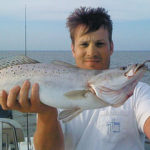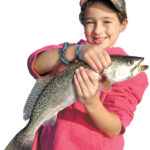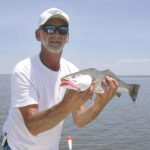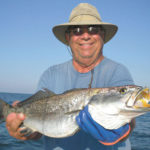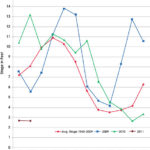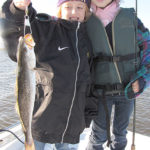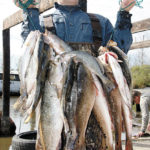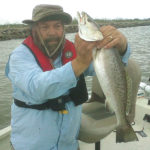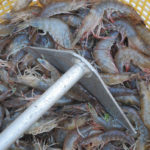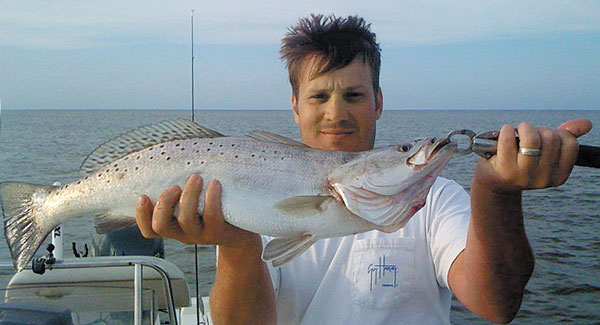
Could this be the year of the trout? After last year’s fishery closures, one certainly might expect there to be more and bigger specks swimming around. So Louisiana Sportsman went to the experts to see what their crystal ball shows.
Louisiana anglers were chomping at the bit for trout season to kick off last spring, and they weren’t disappointed as warming weather led to quick limits all across the coast.
“Shheeeezzz, I have a bunch of fish to clean tomorrow,” LouisianaSportsman.com user John Rucker wrote last April 13 after a trip to Grand Isle. “Was skeptical about going to Grand Isle this morning with the wind forecast 13 to 18 (m.p.h.). Decided to go since I have had GREAT results in my five trips the last two weeks.
“Caught a limit of trout, three reds, four flounder and a drum on my Zoom tiny flukes Carolina rigged in the current.”
And then, only seven days after Rucker’s report, the Deepwater Horizon exploded off the coast and began a months-long regurgitation of crude oil into the Gulf. At first, it was just a curiosity to most anglers, but soon it was apparent this wasn’t a run-of-the-mill leak.
Anglers continued to make trips to the marshes across Southeast Louisiana, but they kept an eye on the happenings off the coast. And as the oil built up, it was soon apparent the 2010 season would be in peril.
On April 30, the first fishing closures were enacted. But even then anglers still hoped for the best. After all, only those waters east of the Mississippi River’s South Pass were closed. Even Lakes Pontchartrain and Borgne remained open.
Within 10 days, however, the closures began eating into the waters west of the river, and over the next two months, there was a sort of cat-and-mouse game played out as state officials closed and reopened waters all across the central and southeastern coast.
All while freely admitting fish in the impacted areas were no danger whatsoever to the angling public’s health.
Finally, the Louisiana Wildlife and Fisheries Commission took control of the situation and ordered all state waters reopened to recreational fishing unless scientific data showed a public health threat.
By then, however, it was the end of August and the bulk of the season had been lost.
While some hit the water and took advantage of the reopened fishing, the beginning of hunting seasons diverted many outdoorsmen’s attention.
Now that anglers have begun turning back to fishing, they are finding fantastic action.
“Fished the Michoud Substation (Intracoastal Waterway) at the Hot Water Canal (on Feb. 25),” LouisianaSportsman.com’s Danny-A (known in Gonzales as Danny Armand). “Let me start by saying WOW!!! BIG trout every few casts.
“It was a blast.”
And Armand told Louisiana Sportsman that he believes the oil spill didn’t have any negative effect on the fishery.
“I think the fish are going to stay away from stuff like that (oil),” he said.
In fact, he said, the closures might have actually had a positive impact on the overall trout fishery in South Louisiana.
“I feel like a lot of the places we fish were overfished,” he said. “I actually think it helped out because a lot of the places that were being overfished were given a break.”
And he said that can only be a good thing for him and other anglers this year, especially since not only recreational anglers but also commercial fishermen were kept off the water much of last year, leaving ample food for hungry trout.
Ed Sexton, one of the featured anglers in the book Trout Masters, concurred.
“Toward the end of the summer when fishing opened back up, I know we were catching bait in our trawls like we’ve never caught that time of year,” Sexton said. “I think that’s going to make trout fishing and redfishing that much better.”
And the overall lack of fishing pressure should logically mean there will be more big trout, the veteran Venice angler said.
“If they weren’t caught last year, they should be bigger this year,” Sexton surmised.
OK, so those seem like logical conclusions to draw, but do they jibe with science? What are the state’s top fishery biologists saying about the impact, both good and bad, of the closures on trout populations?
Harry Blanchet, who for years has been the man to go to in order to sort out speckled trout biology, admitted that Armand’s and Sexton’s hypotheses sound logical.
“You’re going to have some natural mortality, but you would expect overall you would have more large trout in an (unfished) system,” Blanchet said.
However, he added that such an unfished population wouldn’t necessarily grow in terms of overall numbers.
“You have to remember that trout is not your top predator,” Blanchet said. “You would have about the same number of age-1 trout.
“You would have reduced fishing pressure on those older fish, so you have more of those older fish in the system, but you would have about the same recruitment (of juveniles into the age-1 year class).”
He said a long-term suspension of fishing could maximize the impact.
“If you turn off fishing pressure completely for five years, you would have more biomass of trout,” Blanchet said. “They would produce more eggs.”
Add in a suspension of commercial fishing, and the results sound perfect.
“What’s driving the amount of trout in the system is the quantity and quality of the food source,” Blanchet said.
And so by ending all fishing (recreational, as well as commercial) that would, indeed, lead to a larger population of trout — right? Well, maybe not.
“You’ve subtracted one predator,” Blanchet said. “You might end up with a few more sharks. You’re going to end up with more (trout) eggs in the water, but the eggs won’t necessarily survive (to adulthood).”
And then Blanchet, ever ready to throw a wet towel on expectations, dropped the bomb and snatched the discussion back to reality.
“Remember: We really did not turn off trout fishing last year,” he said. “We didn’t turn off fishing. We did actually catch trout. We still had a substantial trout harvest.
“The fair question is how much of an impact will that reduction have on the number of older trout.”
What? Is that what you remember? Did you go fishing in June and July? Did you limit out in early August?
Someone obviously did, and a review of the closures shows that there were, indeed, large portions of the coast open at various times throughout the closure. For instance, inshore waters east of the Mississippi River were closed for only 46 days, while Barataria Bay remained closed for 54 days.
The longest closure hit the mouth of the Mississippi River, which remained closed for 103 days — with the exception of a short-lived catch-and-release window in early July.
To support his assertions that the oil spill didn’t completely shut down fishing, Blanchet and fellow LDWF biologist Jason Adriance pulled out the official 2010 landings estimate compiled by the National Oceanic and Atmospheric Administration.
According to the preliminary NOAA data, recreational anglers in Louisiana caught an estimated 6,927,524 trout for a total weight of nearly 7.5 million pounds.
To put that into perspective, the 6.9 million trout estimated to have been caught in 2010 still outpaced the 30-year average through 2009 of 6.4 million trout.
So SOMEBODY was catching trout.
“You had some pent-up demand, so (anglers) may have taken a few extra trips in the fall that they couldn’t make in the summer,” Blanchet said.
That’s not to say the spill and closures didn’t have an impact: Landings during the height of the closures were sharply down compared to the same time period in 2009.
Specifically, anglers caught 1.5 million trout in May and June of 2010, compared to 3.5 million during the same two-month period of 2009. That’s a difference of 1.9 million fish.
Likewise, anglers landed 991,648 fewer trout in July and August of last year compared to those months in 2009.
But the last four months of the year provided bumper fishing, with 1.2 million more specks cleaned than the same period of 2009.
“If you look at the last two months of 2010, November and December was closer to the average but higher,” Adriance said. “September and October of 2010 was above average.”
At the same time, charter catches plummeted from 1.5 million trout in 2009 to 332,530 fish in 2010 — which reflects the mass exodus of captains from the industry to work for BP during the cleanup.
The bottom line
There weren’t any wholesale die-offs of trout or redfish or pretty much anything else (except perhaps oysters, but those die-offs appear to be more related to freshwater diversions used to minimize oil influxes into the marsh) during the oil spill — and there hasn’t been any significant ramifications manifested over the months since the fisheries were reopened in August.
So is that good news? Does incredible fishing await the surge of trout anglers sure to hit the coastal waters of the state throughout the summer?
Frankly, there is still a lot biologists don’t know going into this trout season because they really aren’t sure what happened last year. Simply put, they weren’t able to continue their normal monitoring of the species during the height of the oil-spill crisis.
“A lot of our productive sites that we sample were in areas we couldn’t get to,” Adriance said.
Now, biologists continued to sample, but they simply caught fewer trout — even when they expanded their sampling stations later in the year.
“That expanded sampling started at a time when we weren’t going to catch as many trout,” Adriance said.
So what can these experts tell us about the upcoming trout-fishing frenzy?
Well, Adriance said satisfaction will depend on our expectations.
“I think we’ll see average to slightly below-average fishing,” he said.
That might sound impossible, but the fact is that the past several years have just been crazy.
“We’re still coming off that (Hurricane) Katrina bump,” Adriance said. “We’ve been catching a lot of trout.”
Again, let’s look at the landing estimates.
From 1981 through 2004, Louisiana anglers landed an estimated average of more than 5.9 million trout annually. The peak was in 2000, when more than 9.6 million specks hit the docks.
And then along came Hurricane Katrina, and the numbers skyrocketed the following four years when the average annual catch jumped to more than 10.8 million trout. While 2007 through 2009 were well above the average, the most-incredible fishing came the year following the hurricane, when anglers snatched an estimated 13.2 million trout from Louisiana waters.
Blanchet explained that what fueled the post Katrina surge was a combination of factors.
First, a huge number of people hitting the water after not being able to fish for months as facilities and individuals dealt with the ramifications of the massive storm.
However, perhaps a more important factor in the jump in the average catch was related to environmental conditions in which trout were living.
“The hurricane put some high-salinity waters all the way in the upper reaches of the system,” Blanchet said.
That, combined with some relatively mild winters and continued dry conditions, resulted in good growth in juvenile trout — which, in turn, resulted in crazy numbers of fish flopping in boxes.
“A lot of things happened at one time to make 2006 a great year,” Blanchet said. “I don’t think we can expect a post-hurricane type of year.”
Why can’t we expect such an incredible year following the closures of 2010?
“You don’t have the confluence of all the factors,” Blanchet explained. “It was both the fishermen and the habitat that worked together to have that really good year (following Katrina).”
Adriance said the cold winter that blanketed much of the U.S. in snow could have an impact on trout fishing well into the summer.
“We don’t know what that snow melt will mean,” he said.
If the river jumps as was predicted in early March (it was projected to move from 3.8 feet in New Orleans to 14 feet by the middle of the month) and remains high for a protracted length of time, fishing could suffer from the Mississippi border around to the western side of Vermilion Bay as the Mississippi and Atchafalaya rivers send fresh water into the marshes.
“We would have lower salinities and lower water temperatures,” Adriance said.
The impact of a sustained high Mississippi River cannot be overstated. A quick look at estimated landings from the first four months of 2010 — before oil began spewing from the Deepwater Horizon and before fisheries were closed — shows just how tough trout fishing can become during high-river periods.
In January and February of 2010, only 101,666 trout were estimated to have been caught when the Mississippi River was well above 10 feet. Compare that to 2009’s 975,080 trout, when the river was less than 8 feet at the New Orleans gauge, and you see just how much trout-fishing success is dependent upon a low river.
Obviously, the fish wouldn’t just turn belly up, but they would move out to find more-comfortable environs and, thus, be less available to anglers looking to fill their ice chests.
However, Blanchet explained that if the river jump is short-lived and there isn’t a deluge of rain that freshens up the marshes, trout could return quickly to their normal haunts and be available to anglers.
“It’s not only the peak but the duration of the rise in the river,” he said. “If we have a very high early peak, that’s not necessarily as detrimental as the high river we had last year that seemed to go on forever.”
The big question that remains to be answered, however, is just what impact last year’s oil spill will have on trout, their food sources and their nurseries.
“We don’t know how much oil on a marsh environment can impact the ability to support juvenile trout,” Blanchet said.
But one thing’s for sure, Adriance said: “An average year in Louisiana is still pretty dang good.”
Area predictions
• Area 1 and 2 (waters from the Mississippi state line to the eastern shore of Venice’s South Pass, including Lakes Pontchartrain and Borgne)
The big variable in much of Southeast Louisiana when talking trout fishing is the Mississippi River. In late February, the river was rock-bottom low. That means salinity levels are more likely to be higher, which generally translates into better fishing for those searching out trout.
However, a major rise in the river was predicted for March, and that could throw a monkey wrench in the fishery — depending upon the duration of the high-water period.
“You get a lot of influence by the river,” Adriance said.
That’s because the fresh water pouring out the mouth of the river doesn’t just mix with the Gulf of Mexico’s salt water and disappear — it generally stays on top of the salt water and curls around with currents to move into the coastal marshes on its eastern and western sides.
So it’s always difficult to nail down the trout forecast in this region.
“It’s going to depend on the right conditions whether fish are on the inside or outside,” Adriance explained.
In other words, it’s all an availability issue, with angler success in Louisiana waters from the Mississippi state line to the east side of the river — including Lake Pontchartrain — largely dependent on the Big Muddy.
“Fish are going to go to where they’re comfortable,” he said.
The biologist who is in charge of monitoring this huge basin said that certainly made for changing conditions during 2010.
“Early last year, we were faced with the possibility of a high Mississippi River and dramatic increases in freshwater input to the system,” Brian Lezina reported. “With such large inputs (of fresh water), most of the basin saw dramatic salinity fluctuations.
“Although trout can survive in a wide range of salinities, this still modifies the available habitat in which they find themselves.”
No, fish don’t just die when these areas are inundated with water. Remember: It’s an availability issue. In other words, the fish simply move out of the fresher waters until they find the salinities in which they are comfortable.
Of course, much of this area was closed to all fishing for part of 2010, and the impacts of that are still being assessed.
However, Lezina reported that there are some indications of things to come from the post-spawn data from 2010 — which was collected later in the year as fisheries reopened.
“Looking at 2010 post-spawn data overall, we do see lightly fewer juvenile trout in fisheries-independent samples than the previous 10-year average,” he said.
That could indicate fewer school trout this year, but Lezina was quick to add in a caveat: “(T)his must also be put into perspective. For some areas around heavy freshwater inputs, trout catches were lower during the summer months; in other areas where salinities were moderated, these catches were near or, in some cases, above ‘average.’”
So what are we to draw from his observations?
“The bottom line is that, although we are seeing slightly less young-of-the-year fish in some of the samples over previous years, this year we should still expect trout abundances to be similar to past years,” Lezina reported.
And then he closed his report as he began it, stressing the importance of river stage.
“While we are seeing low stages now (in late February), with the snowfall up north we are already getting predictions of high river levels,” he wrote. “This will change the target areas as we progress into spring.
“Trout may move to ‘outside’ areas earlier, and the best fishing will be at the outer marshes and islands in Black Bay and Breton Sound in the south and the northern reefs and eastern areas of the Biloxi Marsh system.”
• Area 3 (Barataria Basin)
Much about 2010 remains a mystery in this area, in particular.
“Like most areas, they did see some drop in (catch per unit effort), but a lot of their sampling sites they couldn’t get to,” Adriance said.
However, he really didn’t see the area’s core trout fishery changing just because fishing pressure was eased for several months.
“I wouldn’t expect to see much change there: It tends to be a school-trout area, and it has a lot of fishing pressure,” Adriane said.
LDWF’s area manager Keith Ibos pointed out that, while overall their catch per unit effort was down across the board, the samples using 1-inch-bar gill nets point to some bad news for the area.
“Assuming that the (1-inch bar nets are) a good indicator of recruitment into the recreational fishery, looking at this data we would normally expect a below average year of speckled trout fishing relative to previous years,” Ibos reported.
However, he quickly pointed out that 2010 was — surprise, surprise — “not a typical year.”
“This year’s (fishery) independent samples in areas such as The Pen near Lafitte have shown an increase in freshwater species,” Ibos reported. “It is possible that fish displacement due to increases in fresh water throughout the area, combined with limited angler access to productive fishing areas, not lower numbers, are the reasons for poor (catch per unit effort) in both Davis Pond creel surveys and LDWF fishery-independent samples.”
That being said, Ibos didn’t expect to see a burgeoning population of fish because of the fishing closures.
“(R)educed pressure during the normal peak fishing season in 2010 may not actually result in more available trout in 2011,” he wrote. “Barataria Bay usually does not produce large trout in great numbers. It is reasonable to assume that larger trout will still not be available in any quantity in Barataria Basin.”
That assessment is due to several considerations.
“Continued poor recruitment most of the previous decade, fishing pressure and degrading marsh conditions due to coastal changes have exacerbated the problem,” Ibos reported. “We would expect there not to be much change in the abundance of larger trout in the Barataria Basin in the near future.”
He closed by pointing to traditional hotspots to collect plenty of schoolies to keep anglers busy.
• Area 4 & 5 (Bayou Lafourche to the Atchafalaya River)
Area manager Vince Guillory reported some less-than-exciting news from their sampling in 2010. Namely, that their catch per effort with gill nets from October through December resulted in fewer and smaller trout than the long-term averages.
For instance, the number of trout caught in gill nets in Area 4 (which stretches from Bayou Lafourche to Grand Caillou) was 2.9 per sample, while the average size of these trout tallied up to barely more than 12 inches. The long-term average was 4.5 trout per sample that measured nearly 13 inches.
In Area 5, moving from Grand Caillou to the Atchafalaya River, the catch per sample was 2.3 trout compared to the long-term mean of 2.8 fish. Not a big difference, there.
But the average size of these trout was just short of 11½ inches compared to the nearly 13-inch long-term average.
However, NOAA creel surveys conducted from December 2010 through January seem to be at odds with the creel surveys.
In Area 4, the survey revealed an average 3.2 trout caught per trip during this time frame. That was actually higher than the like periods from 2007-08 through 2009-10. And mean size of these fish was 13.8 inches.
Area 5 creel surveys showed an increase to 2.5 trout per trip versus 1.8 fish per trip in 2009-10, although this winter’s survey results were lower than in 2007-08 and 2008-09. That said, the size of each trout was larger than any of the previous three winter surveys, with the average trout measuring a solid 15 inches.
So after Guillory weighed all the available evidence, he came up with a prediction: No big changes for the coming year.
“Spotted seatrout fishing for the upcoming spring and summer months will probably be similar to recent years,” he said.
He did point out that the average water temperatures in both areas have been lower than the average, and that could mean the fishing gets better as the year ages.
“Peak catches … may occur later in the year because of the temporary displacement of trout into deeper habitats in the larger bays and Gulf of Mexico due to the below-average water temperatures,” Guillory said.
Of course, he also pointed out that much hinges on freshwater influxes into the system.
“Another factor which could influence catches of spotted seatrout this spring and summer is the occurrence of low salinities due to either high local rainfall or high Mississippi/Atchafalaya river discharges,” Guillory concluded. “Low salinities could result in a temporary movement to higher-salinity regions.”
• Area 6 (Atchafalaya River to the western shore of Vermilion Bay)
“This area is directly tied to the Atchafalaya River,” Adriance said.
That pretty much sums up the deciding factor in the trout fishing throughout this entire system. If the river is pouring high volumes of fresh water from its mouth, fishing in the bay will be difficult (perhaps non-existent); if the river bounces up as predicted and then quickly drops out, fishing could be great.
“Generally speaking, when the river level at Butte La Rose averages 8 feet … or less, we anticipate and usually see relatively good fishing for trout in the bays and near-offshore reefs,” area manager Paul Cook explained.
While the forecast in early March was for a huge jump by the middle of the month, Cook pointed out that a high river stage at this point doesn’t necessarily kill the entire season. However, things could get skinny if water levels in the river remain high through April and beyond.
“Flow during the early part of the year (January through March) seems to have little effect on summertime success, while the period of April through June is highly significant,” he reported.
That’s exactly what happened last year, with a prolonged high Atchafalaya River stage ruining fishing until late in the year.
“Recreational fishing effort was basically non-existent during the early part of 2010,” Cook reported. “Conditions conducive to speck fishing were not seen until late summer, with success sporadic at best through September or so.”
All that said, LDWF fishery-independent sampling in the area has revealed a trend of stable or increasing catch rates in most gear types since 2003.
“Several gill-net panels in 2008, 2009 and 2010 samples saw numbers as high as those seen during the drought year of 2000,” Guillory wrote. “Numbers of trout taken in the smaller panels during … 2010 were probably as high as we’ve seen since the inception of the LDWF finfish program.”
That led Guillory to be cautiously optimistic — given the unknowns related to the upcoming river stages.
“All indications are that the local population is healthy, as catch rates in fishery-independent gear has remained stable or seen increases, but those rates appear to have less effect on recreational fishing success than the environmental conditions seen in this dynamic system,” Guillory said.
• Area 7 (Vermilion Bay’s western shore to the Texas state line)
So there’s a lot of coast in this area, but in terms of speckled trout fishing, there are two focal points.
“We’re really talking about Calcasieu and Sabine (lakes),” Adriance said.
And early indications are that this year could be off the charts.
“For the first month of 2011, the spotted seatrout total catch has doubled itself compared to January 2010,” area manager Mike Harbison reported.
This increase also was noted in the number of trout caught in seines last year compared to 2009.
“(Young of the year) trout caught in the seine for 2010 have also doubled from 2009,” Harbison reported.
This is an important indicator, Harbison said, because it points to the next year’s availability of catchable trout.
“That is because those (young-of-the-year speckled seatrout) caught the previous year in the seine will be the 12-inch fish of the current year,” he reported. “The (young-of-the-year) for 2010 was the best it has been since 2006.”
That’s great news for anglers in these systems, but Harbison did point out that there are some concerns about the survivability of juvenile trout.
“The temperature so far has been about like last year, but with more cold spells that may affect the number of juvenile (trout) that survive,” he said. “Extreme low tides may have also played a factor in a possible decline in the number of juvenile (specks).”
However, neither cold spells nor low tides were expected to impact adult fish, he said.
In short, Harbison said anglers should expect a continuation of what they found during last year’s run.
“If you enjoyed fishing in 2010, then 2011 should be no worse,” he reported. “The quantitative data show that fishing should be better for 2011 compared to 2010, but environmental factors could play a role in making it an average year.”
